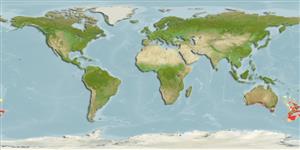Common names from other countries
Environment: milieu / climate zone / depth range / distribution range
Ecología
marino batipelágico; no migratorio; rango de profundidad 180 - 1000 m, usually 270 - 450 m (Ref. 9563). Deep-water; 21°S - 56°S, 113°E - 172°W
Eastern Indian Ocean and Southwest Pacific: Australia ( Western Australia, South Australia, Victoria, New South Wales and Tasmania) and New Zealand.
Tamaño / Peso / Age
Maturity: Lm ? range ? - ? cm
Max length : 51.3 cm TL macho / no sexado; (Ref. 128324); 60.7 cm TL (female)
Espinas dorsales (total) : 0; Espinas anales: 0. Head with scarcely developed ridges; eyes large; chin barbel short; light organ small, adjacent to anus. First dorsal-fin spine smooth. Scales densely covered with lanceolate spinules, arranged in quincunx or convergent rows.
Occurs on the continental slope (Ref. 9563).
Life cycle and mating behavior
Maturities | Reproducción | Spawnings | Egg(s) | Fecundities | Larva
Cohen, D.M., T. Inada, T. Iwamoto and N. Scialabba, 1990. FAO species catalogue. Vol. 10. Gadiform fishes of the world (Order Gadiformes). An annotated and illustrated catalogue of cods, hakes, grenadiers and other gadiform fishes known to date. FAO Fish. Synop. 125(10). Rome: FAO. 442 p. (Ref. 1371)
IUCN Red List Status (Ref. 130435)
CITES (Ref. 128078)
Not Evaluated
Threat to humans
Harmless
Human uses
Pesquerías: escaso valor comercial
Herramientas
Special reports
Download XML
Fuentes de Internet
Estimates based on models
Preferred temperature (Ref.
115969): 6.9 - 12.5, mean 9.2 (based on 58 cells).
Phylogenetic diversity index (Ref.
82804): PD
50 = 1.0000 [Uniqueness, from 0.5 = low to 2.0 = high].
Bayesian length-weight: a=0.00129 (0.00082 - 0.00202), b=3.14 (3.01 - 3.27), in cm Total Length, based on LWR estimates for this species & (Sub)family-body (Ref.
93245).
Nivel trófico (Ref.
69278): 3.7 ±0.53 se; based on food items.
Resiliencia (Ref.
120179): Bajo, población duplicada en un tiempo mínimo de 4.5-14 años (Assuming tm>4).
Fishing Vulnerability (Ref.
59153): Moderate vulnerability (44 of 100).
Climate Vulnerability (Ref.
125649): Moderate to high vulnerability (50 of 100).
